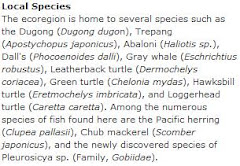 Factory on the Yellow Sea -- Pollution.
Factory on the Yellow Sea -- Pollution.Among the 63 large marine ecosystems (LMEs) in the world ocean, the Yellow Sea has been one of the most significantly affected by human development. Today the Yellow Sea faces serious environmental problems, many of a transboundary nature, that arise from human impact.
Large cities near the sea having tens of millions of inhabitants include Qingdao, Tianjin, Dalian, Shanghai, Seoul, etc. People of these urban areas are dependent on the Yellow Sea as a source of marine resources for human nutrition, economic development, recreation, and tourism, and the Yellow Sea receives industrial and agricultural wastes from these activities.
The rapid growth of the human populations and economies of China and South Korea is causing serious loss and degradation of coastal habitats, and the declining river flows and high levels of pollution are leading to reduced benthic productivity and, thus, a decline in food supplies for many birds and marine animals.
The resource is also threatened by overfishing. This sea was once one of the most intensively exploited in the world. Today, the major fisheries are at an extremely low level compared with 3 decades ago.
- Fishing (human nutrition)
- "Port of Dalian" (development of boats technology)
- Dalian Harbour (ship transport)
- Military (Marines)
- Factories
- Tourism (money)
- Recreation (big cities)
The Yellow Sea has favorable oil and gas bearing prospects. However, no positive results have ever been reported.
Recreation
- Beaches
- Hot air balloon
- Hang gliding and paragliding
- Hotels and Resorts
- Surfing
- Whale watching
- Aquarium (about 17 in the area)
- Zip line
- Best sea food
- Shore excursions and cruises
- Scuba diving
- Marines Memmorial
- Shipwreck dive tours



1 comment:
great job
Post a Comment